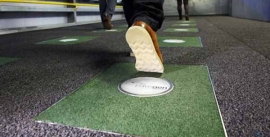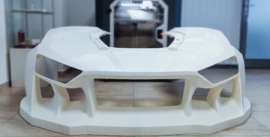 جدید
جدیدتبدیل نانوساختارها به مواد فلزی سبک و منعطف چاپ شده سه بعدی با ابعاد بزرگ
تبدیل نانوساختارها به مواد فلزی سبک و منعطف چاپ شده سه بعدی با ابعاد بزرگ

تبدیل نانوساختارها
به مواد فلزی سبک و منعطف
چاپ شده سه بعدی با ابعاد بزرگ
[box type=”shadow” align=”alignright” ]
محققان فرامادهي فلزی سلسله مراتبی با معماري سه بعدي شبه فرکتال چند لایه اي را براي ایجاد ساختارهايي در مقیاس سانتیمتر در ترکیب با ویژگی های مقیاس نانو توسعه داده اند.
[/box]
[box type=”success” width=”1024″ ] ترجمه از گروه ترجمه ایران مواد
حرفه ای ترین تیم ترجمه مهندسی مواد کشور
[/box]
سالها، دانشمندان و مهندسان، موادي در مقياس نانويي را سنتز ميكنند تا از خواص مکانیکی، نوری و انرژی آنها بهره برند، اما تلاش ها براي توليد این مواد در اندازه های بزرگتر به عملکرد و تمامیت ساختاری تقليليافته منجر شده است.
اكنون، محققان به رهبري شیویو “رایان” ژنگ، استادیار مهندسی مکانیک در ویرجینیا تک مطالعهاي را در مجله Nature Materials منتشر کرده اند که نوعي فرآیند جدید برای ایجاد مواد فلزی نانوساختار سبک، قوی و فوق العاده الاستیک با استفاده از چاپ 3D با مقیاس پذیری بیسابقه، با كنترل هفت برابر برزگتر از معماری 3D دلخواه را توصيف ميكند.
به صورت چشمگیري، این مواد فلزی چند مقیاسی خاصيت سوپرالاستيستيهاي را به دلیل نانو لولههای توخالی و نظم معماريِ 3 بعدي سلسله مراتبی طراحیشده نشان داده اند، كه به بیش از 400 درصد افزایش الاستیسیته کششی نسبت به فلزات و فومهاي سرامیکي سبک وزن معمول منجر شده است.
رویکرد فوق الذكر، که به تولید سطوح چندگانهي شبكههاي سلسله مراتب 3D با ویژگیهایي در مقیاس نانو ميپردازد، میتواند در هر جايي كه نیاز به ترکیبی از سفتی، استحكام، کم وزن، انعطاف پذیری بالا ميباشد- از جمله در ساختارهايي كه در فضا مستقر می شوند، زره هاي انعطاف پذیر، وسایل نقلیه سبک و باتری ها مفید است كه دريچه ي جديدي بر کاربردهای هوافضا، نظامی و صنایع خودرو مي گشايد.
مواد طبیعی، مانند استخوان و انگشتان پاي مارمولك خانگي، با سطوح مختلف معماریهاي 3D از مقیاس نانو به ماکرو تکامل یافته اند. مواد ساختهي دست بشر هنوز بايد به این کنترل ظریف از ویژگیهای ساختاري برسد.
ژنگ، نویسنده ارشد این مطالعه و رهبر تیم تحقیقاتی ميگويد: “ایجاد ویژگیهای میکرو سلسله مراتبی سه بعدي با هفت مرتبه بزرگی در ظرفيت ساختاریِ محصولات بی سابقه است. ” “با گردآوري ویژگی های مواد در مقیاس نانو به شمش هاي موادي از طریق معماری چندلایه ، شما شروع به دیدن انواع خواص مکانیکی برنامه ریزی شده مانند وزن حداقل، استحكام حداکثر و سوپرالاستيسيته در مقیاس سانتیمتر مي كنيد.”
روندي كه ژنگ و همکارانش برای ایجاد مواد استفاده کردند یک نوآوری در روش چاپ 3D نوري دیجیتال است که بر مبادلات فعلی بین دقت بالا و حجم ساخت، يعني محدودیت عمده در مقیاس پذیری ميكروشبكه ها و نانوشبكه هاي چاپ شده ي 3 بعدي كنوني، غلبه كرده است.
مواد مرتبطي که میتواند در مقیاس نانو مانند ورقهاي گرافن تولید می شود 100برابر قویتر از فولاد است، اما تلاش براي افزايش اندازه ي این مواد در سه بعد استحكامشان را با هشت مرتبه بزرگی تنزل مي دهد كه به عبارت دیگر، آنها را 100میلیون بار کمتر مستحكم ميكند.
ژنگ افزود: ” قابلیت ارتجاعی و انعطاف پذیری افزایش يافته ي از طریق اين فرایند و طراحی جدید بدون ترکیب پلیمرهای نرم به دست می آیند، در نتیجه استفاده از مواد فلزی را به عنوان حسگرهاي منعطف يا ادوات الکترونیکي در محیط های خشن، که در آن مقاومت در برابر مواد شیمیایی و مقاومت دمایي مورد نیاز است، مناسب مي سازد.”
این شبکه سلسله مراتبی چندلایه نیز بدان معنی است كه سطح بیشتری برای جمع آوری انرژی هاي فوتوني از آنجاييکه آنها میتوانند به ساختار از تمام جهات وارد شوند، در دسترس است و نه تنها از طريق سطح، مانند پنل های فتوولتائیک سنتی که در داخل ساختار شبکه اي جمع آوری شوند. یکی از فرصت های بزرگي كه این مطالعه فراهم مي كند، توانایی تولید مواد چند منظورهي غيرآلي مانند فلزات و سرامیک هايي براي بررسي خواص فوتونی و ذخيره ي انرژی در این مواد جدید است.
علاوه بر این ژنگ، اعضای تیم شامل دانش آموزان فارغ التحصیل ویرجینیا تک هواچن کوی و دا چن از گروه ژنگ و همکارانش در آزمایشگاه ملی لارنس لیورمو هستند. اين پژوهش تحت حمایت تحقيقاتي اداره شده توسط وزارت از انرژی آزمایشگاه لارنس لیورمور به کارگردانی و حمایت های اضافي ویرجینیا تک، صندوق SCHEV از ایالت ویرجینیا و آژانس پروژه های تحقیقاتی پیشرفته دفاعی انجام شد.
مقاله چاپ شده:
Xiaoyu Zheng, William Smith, Julie Jackson, Bryan Moran, Huachen Cui, Da Chen, Jianchao Ye, Nicholas Fang, Nicholas Rodriguez, Todd Weisgraber, Christopher M. Spadaccini. Multiscale metallic metamaterials. Nature Materials, 2016; DOI: 10.1038/nmat4694
[box type=”info” align=”alignright” width=”1124″ ]منبع : sciencedaily
ترجمه : مریم آزاده [/box]
[divider]
Upsizing nanostructures into light, flexible 3-D printed metallic materials
For years, scientists and engineers have synthesized materials at the nanoscale level to take advantage of their mechanical, optical, and energy properties, but efforts to scale these materials to larger sizes have resulted in diminished performance and structural integrity.
Now, researchers led by Xiaoyu “Rayne” Zheng, an assistant professor of mechanical engineering at Virginia Tech have published a study in the journalNature Materials that describes a new process to create lightweight, strong and super elastic 3-D printed metallic nanostructured materials with unprecedented scalability, a full seven orders of magnitude control of arbitrary 3-D architectures.
Strikingly, these multiscale metallic materials have displayed super elasticity because of their designed hierarchical 3-D architectural arrangement and nanoscale hollow tubes, resulting in more than a 400 percent increase of tensile elasticity over conventional lightweight metals and ceramic foams.
The approach, which produces multiple levels of 3-D hierarchical lattices with nanoscale features, could be useful anywhere there’s a need for a combination of stiffness, strength, low-weight, high flexibility — such as in structures to be deployed in space, flexible armors, lightweight vehicles and batteries, opening the door for applications in aerospace, military and automotive industries.
Natural materials, such as trabecular bone and the toes of geckoes, have evolved with multiple levels 3-D architectures spanning from the nanoscale to the macroscale. Human-made materials have yet to achieve this delicate control of structural features.
“Creating 3-D hierarchical micro features across the entire seven orders of magnitude in structural bandwidth in products is unprecedented,” said Zheng, the lead author of the study and the research team leader. “Assembling nanoscale features into billets of materials through multi-leveled 3-D architectures, you begin to see a variety of programmed mechanical properties such as minimal weight, maximum strength and super elasticity at centimeter scales.”
The process Zheng and his collaborators use to create the material is an innovation in a digital light 3-D printing technique that overcomes current tradeoffs between high resolution and build volume, a major limitation in scalability of current 3-D printed microlattices and nanolattices.
Related materials that can be produced at the nanoscale such as graphene sheets can be 100 times stronger than steel, but trying to upsize these materials in three dimensions degrades their strength eight orders of magnitude — in other words, they become 100 million times less strong.
“The increased elasticity and flexibility obtained through the new process and design come without incorporating soft polymers, thereby making the metallic materials suitable as flexible sensors and electronics in harsh environments, where chemical and temperature resistance are required,” Zheng added.
These multi-leveled hierarchical lattice also means more surface area is available to collect photons energies as they can enter the structure from all directions and be collected not just on the surface, like traditional photovoltaic panels, but also inside the lattice structure. One of the great opportunities this study creates is the ability to produce multi-functional inorganic materials such as metals and ceramics to explore photonic and energy harvesting properties in these new materials
Besides Zheng, team members include Virginia Tech graduate research students Huachen Cui and Da Chen from Zheng’s group, and colleagues from Lawrence Livermore National Laboratory. The research was conducted under the Department of Energy Lawrence Livermore Laboratory-directed research support with additional support from Virginia Tech, the SCHEV fund from the state of Virginia, and the Defense Advanced Research Projects agency.








دیدگاه کاربران